Header logo
header top contact widget
Stroke
Healthy Gums Advantageous To A Healthier YOU!
Posted on Apr 22, 2024 by William J. Claiborne, DDS MS
Periodontal (gum) disease and subsequent tooth loss has damaging effects to an individual, far beyond the mouth. When this was suspected decades ago, it prompted national agencies to track the oral health of the U.S. population. Using this extensive data, studies have revealed some interesting statistics, including how various age groups fare when it comes to oral wellness.
The following is mostly information pulled from the National Institutes of Health’s (NIH) “Oral Health In America” report. Released in December 2021, the findings were the culmination of years of research assembled by more than 400 contributors.
On a positive note, the percentage of Americans who have experienced tooth loss has declined since the 1970’s. As of 2016, complete tooth loss has fallen by more than 75% for adults between the ages of 65 – 75 years. Unfortunately, there is not good news when it comes to tooth decay – for nearly any adult age group.
For adults between the ages of 20 – 64, cavities have affected 90% and gum disease exists for nearly 50% of adults aged 45 – 64 years. This should be a concern for every American. This is because research has determined that the bacteria of periodontitis (advanced gum disease) can trigger or worsen a long list of serious health problems.
The list includes:
• Stroke
• Coronary Artery Disease
• Arthritis
• Diabetes
• Preterm & low birth weight babies
• Some Cancers (including oral and pancreatic)
• Alzheimer’s disease
• Impotency, Erectile Dysfunction (ED)
• Prostatitis (elevated PSA levels)
In addition to poor oral hygiene routines at home and avoiding regular dental cleanings and exams, high-risk behaviors (such as use of tobacco, opioids, and alcohol) accentuate the risks of gum disease.
Although gum disease can begin without obvious signs or symptoms, the most commonly noticed are:
• Red, swollen or tender gums
• Seeing blood in the sink when brushing
• Receded gums
• Loose or separating teeth
• Pus pockets on gum tissues
• Sores in the mouth
• Persistent bad breath
While the report found that there are stark differences in adult groups who had less access to having regular oral health care, disparities also stem from underlying economic, demographic, and societal inequities.
Below are some of the oral health variations pertaining to certain groups.
ADOLESCENTS
During the past 20 years, the percentage of adolescents (ages 12 − 19) having at least one molar with a sealant applied has nearly tripled, from 18% to 48%. That’s a good thing. Even so, there has been no decline in untreated tooth decay in adolescents since the last surgeon general’s report twenty years ago.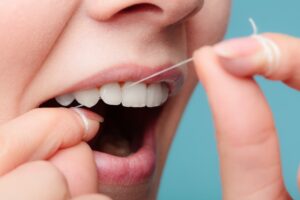
High caries (cavities in teeth) experienced in early childhood is the strongest indicator of caries problems that will be experienced in adolescence and adulthood. This means that when the factors contributing to developing cavities in childhood persist, the incidence of caries affecting permanent teeth will continue to increase during adolescence. Likewise, misalignment of teeth that exist or develop during adolescence can substantially impact eating, speech, gum health, and even psycho-social development. (Imagine a teen with teeth so mispositioned that they are ridiculed by peers.)
OLDER AMERICANS
There is good news for our older population (Americans over the age of 65). Their overall oral health has significantly improved over the past two decades with fewer teeth being extracted. Additionally, the proportion of the population with edentulism (no remaining natural teeth) is at an all-time low.
The not-so-great news… tooth loss remains a problem for older adults. Today, 1 in 6 Americans have no remaining natural teeth. At this rate, by the year 2030 (just 6 years from now), the 65-&-over age group without teeth will increase to 1 in 5.
For adults over the age of 75, the challenges are even greater. Over 54% have fewer than 21 remaining teeth with the number increasing to 80% for those living in poverty. With age also comes the increased prevalence of systemic diseases that may impact the mouth, making older adults more susceptible to oral health issues. (This includes heart disease, diabetes, arthritis, etc.)
Fortunately, things are moving in a positive direction for older adults, with more keeping their teeth than any previous generation. This has largely been the result of having increased attention on the benefits of prevention and improvements in treatments for gum disease and cavities, along with a decrease in the rate of smoking. (About 8 of every 100 adults – 8.3% – of adults 65 years and older were reported to smoke in 2023.)
WOMEN
Women have unique oral health concerns due to changing hormone levels based on menstrual cycles, pregnancy, and menopause. These fluctuations can raise the risk of oral problems that effect teeth or gums. Health issues, such as diabetes, can also affect the oral health of females.
To keep your teeth healthy, it is important to remove dental plaque. This is a sticky, colorless film of bacteria that coats teeth and gums. Plaque buildup can cause tooth decay and gum disease.
Even teeth that already have fillings are at risk for tooth decay. Plaque can build up underneath a chipped filling and cause new decay. And if there are areas in your mouth where your gums have pulled away from the teeth (known as receded gums or gum recession), the exposed tooth roots can decay as well.
It’s important – for all ages – to be committed to their oral hygiene time at the sink, at least twice a day. Devoting these minutes to the care of your teeth and gums will pay off in future years, helping to minimize costs for dental repairs and time in treatment. And, when early ages get into the habit of an oral care routine at home, they are more likely to carry that into adulthood.
Here are some easy brushing tips:
• Use fluoride toothpaste, which is an ingredient of many products. Fluoride protects teeth from cavities, helping to strengthen the tooth’s hard outer surface – the enamel.
• Angle the bristles toward the gumline so they can sweep away bacteria between the gums and teeth.
• Brush gently using small, circular motions. Do not scrub hard back and forth, which can wear down tender gum tissues and wear away tooth enamel.
• Brush all sides of each tooth and the tops (where debris and bacteria can hide within grooves).
• Brush your tongue, especially towards the back where the majority of bacteria embed. Swish well with water at least twice afterwards.
Cleaning between teeth to remove plaque is also part of a good oral hygiene routine. If plaque is not removed, some of it can harden below the gum line and irritate the gums. The gums become red, swollen, and may bleed easily. These are signs of gingivitis. Gingivitis caused by plaque buildup is a mild form of gum disease, and you can usually reverse it with daily brushing and flossing.
If plaque stays on your teeth for too long, it can harden. This hardened plaque is called calculus, or tartar. The only way to remove tartar is to have your teeth cleaned by a dentist or dental hygienist. If the tartar is not removed, the gingivitis can get worse and lead to more severe gum (periodontal) disease. In advanced stages, gum disease causes sore, bleeding gums; painful chewing problems; loose teeth; and even tooth loss.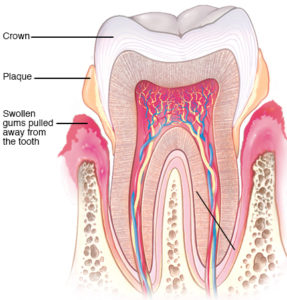
Here are some additional ways to keep a healthy smile with practical measures.
- Floss to remove plaque, and food particles, from between your teeth.
- Visit the dentist for routine check-ups and professional cleaning. If you are at a high risk for tooth decay (for example, if you have a dry mouth because of medicines you take), your dentist or dental hygienist may give you a fluoride treatment, such as a varnish or foam during the office visit.
- Drink fluoridated water. Drinking water with the right amount of fluoride protects your teeth throughout the day.
- Don’t smoke. Smoking increases your chance of gum disease. If you smoke and want to quit, there are many resources to help you: FDA’s Center for Tobacco Products, CDC’s Quit Smoking website, and the BeTobaccoFree.gov website.
- If you are planning to become pregnant, have a dental checkup. Because of hormonal changes, pregnant women may develop gingivitis and experience gums that are swollen and bleed easily. During pregnancy, it is especially important to practice good oral hygiene to maintain the health of your gums.
- Eat a diet that is low in sweets and sugary drinks.
A periodontal specialist is your best advocate in restoring or maintaining healthy gums. In addition to the skills in treating all stages of gum disease (from gingivitis to periodontitis), a periodontist specializes in the selection and placement of dental implants.
If you have signs or symptoms that may be indicative of gum disease, please know this disease will only worsen without treatment. Call 828-274-9440 to schedule an appointment or ask to begin with a consultation.
If dental fear is a concern, we can discuss oral or IV sedation options. These are administered safely with skilled staff members who use advanced safety equipment throughout your care.
Additionally, if you’ve delayed care due to cost, we office several payment plans that many patients find helpful. These plans can break costs into monthly payments, often with no down payment required.
Sources:
https://www.nidcr.nih.gov/health-info/oral-hygiene
https://www.nidcr.nih.gov/research/oralhealthinamerica/section-2b-summary
https://www.nidcr.nih.gov/research/oralhealthinamerica/section-3b-summary
https://www.nidcr.nih.gov/research/oralhealthinamerica/section-3a-summary
https://www.womenshealth.gov/a-z-topics/oral-health
https://www.cdc.gov/tobacco/data_statistics/fact_sheets/adult_data/cig_smoking/index.htm
What You May Be Doing To Increase Potential For Gum Disease
Posted on Apr 11, 2024 by William J. Claiborne, DDS MS
There’s a saying: “We don’t know what we don’t know.”
That applies to so much in life. With all good intentions, adults go about their days feeling they are doing what is right. However, we occasionally learn that what we thought was right is to our detriment.
For example, decades ago, people felt that rigorous scrubbing of teeth with a hard toothbrush and baking soda was a good way to clean your teeth. We now know that the hard bristles and abrasive substances can wear down tooth enamel and scrub away tender gum tissues.
And, there are ways that we actually – and unconsciously – add to the risks for developing periodontal disease.
Over the years, research has continuously shown that the bacteria of periodontal disease can have a number of harmful effects – in the mouth and further. Because these inflammatory bacteria can enter the bloodstream and travel throughout the body, research has shown that they can activate or worsen a number of serious health problems. These include:
– heart disease
– stroke
– Alzheimer’s disease and dementia
– arthritis
– diabetes
– preterm babies
– erectile dysfunction (ED)
– some cancers (including lung and pancreatic)
– obesity
Signs of gum disease include bleeding or sore gums, persistent bad breath, receded gums, and/or gums that are red rather than a healthy pink. These are warning signs since gum disease will only worsen without treatment.
As gum disease progresses, gums begin to pull away from the base of teeth, gums become very tender and bleed easily when brushing, pus pockets form on gums and teeth may shift or loosen.
Unfortunately, gum disease is ignored too often by adults in the U.S. The CDC estimates that over 47% of Americans have some level of gum disease, which is also the leading cause of tooth loss.
Bacterial overload can leave the body’s natural defense response, white blood cells, unable to conquer the infection. Thus, bacteria overload in the mouth triggers an inflammatory reaction begins, which is the beginning of gum disease.
Below are things that can increase the risk for gum disease, some of which you may not realize are contributors:
Aging: Studies have indicated that the incidence of periodontal disease increases as we get older. Over 70% of adults who are aged 65 and older have some form of gum disease.
Some Existing Health Problems: People who have diseases such as cancer or heart problems already have weaker immune systems. When the bacteria of gum disease enter the bloodstream through tears in oral tissues, harmful clotting factors and proteins can occur elsewhere in the body. Research has linked gum disease bacteria with heart disease, diabetes, stroke, preterm babies, and memory loss.
Dry Mouth: Smoking, certain medications, drinking alcohol and aging all contribute to a dry mouth. The saliva in your mouth plays an important part in removing food particles and bacteria. When insufficient saliva cannot cleanse the mouth adequately, bacteria buildup results.
Stress: It has been proven that people who endure long-term stress have a greater risk for developing diseases such as cancer, hypertension and even gum disease. Stress takes a toll on the body’s entire operation, weakening its ability to fight infection.
Medications: The side effects of some drugs can dry out oral tissues and even weaken the density of bones, opening the door for gum disease. Like your physician, your dentist should have an up-to-date list of all medications you take, including herbal supplements.
Grinding Teeth: When you grind and clench your teeth during sleep, the teeth wear down and connective oral tissues are weakened. When the tissues surrounding your teeth are vulnerable, your entire jaw bone area is exposed to certain infections, which can lead to gum disease.
Genetics: Because of genetics, you can be predisposed to develop gum disease. Research indicates that 30% of the population may be genetically susceptible to gum disease.
Gender: Periodontal disease occurs more in men than women (56% vs. 38%).
Smoking: Smoking dries out the tissues in the mouth, increasing one’s susceptibility to calculus. Research shows that smokers lose more teeth than nonsmokers and typically require longer healing times after treatment with results that are less predictable.
A periodontist is a specialist in the treatment of all stages of gum disease and in the placement of dental implants. He or she is the expert who can help to restore a bacteria-burdened “oral cavity” to a healthy state.

Dr. William Claiborne,
Biltmore Periodontics
In our Asheville periodontal dental office, we feature some of the most advanced technology in the industry. The patient benefits from these through diagnoses that are exact, more conservative treatment, and having reduced healing time. This also can mean there is less discomfort.
One of the features we provide is the LANAP Protocol Using Periolase MVP-7. LANAP (an acronym for Laser-Assisted New Attachment Procedure) is amazing technology that more efficiently and effectively treats periodontitis (advanced gum disease) with the PerioLase® MVP-7™ laser. As a minimally invasive (non-surgical) treatment for moderate to severe periodontal disease, LANAP has even been found to stimulate bone regrowth in damaged areas.
If you are experiencing symptoms of gum disease, call 828-274-9440. In our state-of-the-art Asheville periodontal dental office, our patients are treated with respect, compassion and a gentle touch. New patients are always welcome.
If dental fear has kept you from having regular dental care and you’re experiencing symptoms of gum disease, consider starting with a consultation. During this time, we can discuss comfort options, including oral and IV sedation (“twilight sleep”). Referrals are not required.
How A Periodontist Can Help Cancer Patients
Posted on Mar 18, 2024 by William J. Claiborne, DDS MS
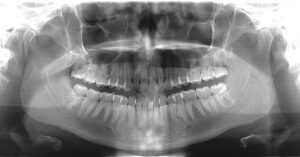
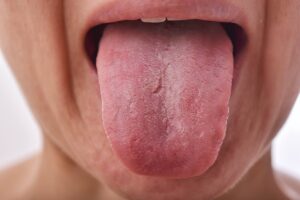
Dental Fear Can Be Detrimental To More Than Your Smile
Posted on Feb 15, 2024 by William J. Claiborne, DDS MS
There are varying figures on the prevalence of dental fear in the U.S. However, there is no argument that it exists and affects a rather substantial number of adults.
A 2018 study shared by Dental Products Report listed the results of a study of things that keep adults from going to the dentist. Over 60% of the 18,000 polled admitted to having dental fear. Four percent shared they had never gone to a dentist as a result.
https://www.dentalproductsreport.com/view/study-finds-more-60-percent-people-suffer-dental-fear
Another study by the Cleveland Clinic stated that about 36% of people in the U.S. have a fear of dental treatment, with 12% having an extreme fear (known as “dental phobia”).
While traumatic experiences in the past (often as a child) cause some people to be fearful of dental visits, others are not aware of why or how their fears began.
The Cleveland Clinic cites the top reasons that cause people to avoid or delay dental care are:
• Fear that the anesthetic won’t be sufficient or fear of the side effects (such as numb lips) after treatment
• Fear of bleeding during a dental procedure
• Fear gagging, choking or not being able to breathe or swallow during treatment
• Fear of dentist (often due to a bad experience in the past)
• Fear of pain
• Fear of needles
• The noise made by drills or other instruments used by the dentist or hygienist
• The smells of antiseptics or other chemicals used in a dental office
https://my.clevelandclinic.org/health/diseases/22594-dentophobia-fear-of-dentists
Having the jitters at the dental office is not all that difficult to understand. During these visits, patients are positioned on their backs on a narrow recliner with a bright light shining in their faces. Add to that having to maintain an open mouth (which is full of sensitive nerves) without really knowing what is being done. It’s not surprising that there are some uneasy feelings.
Fear or anxiety are normal reactions of the brain’s “fight or flight” response. For instance, some people have an intense fear of spiders or heights. Their reactions are automatic. Yet, in many cases of dental fear, some learn to override these reactions once they develop a sense of trust in being treated gently and respectfully.
In addition to avoiding care due to fear, some of the oral health problems we see occur from:
– Insufficient oral hygiene
– Avoiding regular dental check-ups and cleanings
– Ignoring symptoms of gum disease, such as seeing blood in the sink when brushing
– Brushing too rigorously or using abrasive substances to brush
– Age-related problems, such as oral dryness
– Oral dryness due to snoring or sinus problems
– Eating a high-carb diet or snacking frequently
– Smoking (including cigarettes, vaping, marijuana, and chew)
– Regular alcohol consumption
Certainly, some people are merely more susceptible to dental decay and bacterial buildup in the mouth. It can be due to genetics or some illnesses and diseases. Yet, the majority of reasons for having oral problems can be dealt with through proper at-home care and having regular dental exams.
When dental care is delayed or avoided due to fear, small problems that could have been prevented (or easily resolved) become big problems. Big problems require more extensive procedures, more expense and more time in treatment. When dental needs become more significant, fearful patients are actually adding to their reasons to dread the dentist.
Too, when regular dental check-ups and cleanings are avoided, the result can lead to periodontal (gum) disease, which is the nation’s leading cause of adult tooth loss. Periodontal disease occurs when an over-accumulation of oral bacteria become infectious. As it penetrates gum tissues, it also attacks the bone structures underneath the gums. This disease requires treatment that is more extensive.
Additionally, tooth loss can create an entirely new set of procedural needs and costs.
For the individual who has high anxiety or fear associated with dental visits, how are they supposed to set aside these obstacles in order to receive the dental care they need? Obviously, problems in the mouth can easily exacerbate when the signs and symptoms of gum disease are back-burnered.
At our Asheville periodontal dental office, we believe that an informed patient is a healthier patient. Understanding what the problems are and what we are doing to attend to them often helps to keep the patient involved with their oral health. It also tends to help the patient relax.
As a periodontist, I feel it’s important for every adult to know the signs and symptoms of gum disease:
Gums that bleed easily
Red, swollen, tender gums
Persistent bad breath
Gums that pull away from the teeth (recede)
Changes in the way teeth fit together when biting
Changes in the fit of partial dentures
Permanent teeth that loosen or separate
When any of these emerge, prompt treatment can minimize treatment time and costs. However, ignoring the warning signs merely allows the disease to progress further – requiring more time in treatment and greater expense.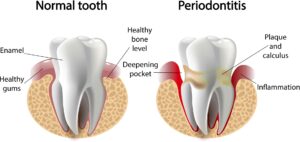
In addition to the related problems of cavities, bad breath and tooth loss, the inflammatory bacteria of gum disease can impact overall health. Years of studies have found frightening correlations between oral bacteria and the worsening or development of serious diseases.
Research has found that the oral bacteria of gum disease (which affects over 47% of the nation’s adult population) can enter the bloodstream. Once bloodborne, this bacteria has been found to trigger inflammation that has been associated with a wide range of serious health problems. Research has shown links between these infectious bacteria to heart disease, stroke, diabetes, arthritis, some cancers, preterm babies, erectile dysfunction (ED) and even Alzheimer’s disease.
I am very proud of the relationship of trust my team and I have with our patients. They know our goal is to never cause them discomfort. Although we cannot always guarantee they’ll have no discomfort at all, we take extra steps to provide optimal comfort at every visit.
In addition to this commitment, we offer oral sedation and I.V. sedation (also referred to as “twilight sleep”).
Oral sedation is a pill that helps patients relax. It also has an amnesiac effect, leaving most with little or no memory of treatment afterward. I.V. sedation places the patient in a deeper sleep state, also erasing memory of the procedure. It is administered by a doctor of anesthesiology, overseen by Dr. Brad Stone, a Medical Doctor (MD) and a board certified Anesthesiologist & Pediatric Anesthesiologist.
https://www.biltmoreperiodontics.com/comprehensive-care-team/
With both sedation options, patients are closely monitored with advanced safety equipment throughout treatment.
If fear has prevented you from a healthy smile, schedule a consultation in our Western NC periodontal dental office. During this time, we can discuss comfort options that may be best for your individual needs. Call 828-274-9440.
Recent Posts
Categories
Archives
- September 2024
- August 2024
- July 2024
- June 2024
- May 2024
- April 2024
- March 2024
- February 2024
- January 2024
- December 2023
- November 2023
- October 2023
- September 2023
- August 2023
- July 2023
- June 2023
- May 2023
- April 2023
- March 2023
- February 2023
- January 2023
- December 2022
- November 2022
- October 2022
- September 2022
- August 2022
- July 2022
- June 2022
- May 2022
- April 2022
- March 2022
- February 2022
- January 2022
- December 2021
- November 2021
- October 2021
- September 2021
- August 2021
- July 2021
- June 2021
- May 2021
- April 2021
- March 2021
- February 2021
- January 2021
- December 2020
- November 2020
- October 2020
- September 2020
- August 2020
- July 2020
- June 2020
- May 2020
- April 2020
- March 2020
- February 2020
- January 2020
- December 2019
- November 2019
- October 2019
- September 2019
- August 2019
- July 2019
- June 2019
- May 2019
- April 2019
- March 2019
- February 2019
- January 2019
- December 2018
- November 2018
- October 2018
- September 2018
- August 2018
- July 2018
- June 2018
- May 2018
- April 2018
- March 2018
- February 2018
- January 2018
- December 2017
- November 2017
- October 2017
- September 2017
- August 2017
- July 2017
- June 2017
- May 2017
- April 2017
- March 2017
- February 2017
- January 2017
- December 2016
- November 2016
- October 2016
- September 2016
- August 2016
- July 2016
- June 2016
- May 2016
- April 2016
- March 2016
- February 2016
- January 2016
- December 2015
- November 2015
- October 2015
- September 2015
- August 2015
- July 2015
- June 2015
- May 2015
- April 2015
- March 2015
- February 2015
- January 2015
- December 2014
- November 2014
- October 2014
- September 2014
- August 2014
- July 2014
- June 2014
- May 2014
- April 2014
- March 2014
- February 2014
- January 2014
- December 2013
- November 2013
- October 2013
- September 2013
- August 2013
- July 2013
- June 2013
- May 2013
- April 2013
- March 2013
- February 2013
- January 2013
- December 2012
- November 2012
- October 2012
- September 2012
- August 2012
- July 2012
- June 2012


